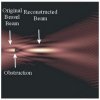Scientists in the UK have created a novel set of “optical tweezers” that can simultaneously pick up particles located in different places and manipulate the trapped particles in unison. Kishan Dholakia and colleagues at St Andrews University made the device using a laser beam that can “self heal” after encountering a trapped particle. The tweezers could be used in advanced micromachining and to control arrays of lab-on-a-chip devices. (V Garcés-Chávez et al. 2002 Nature 419 145).

Optical tweezers manipulate particles by using a laser beam to induce an electric dipole moment in the particles. Drawn to the most intense part of the laser’s electric field, the particles can then be picked up, moved and released by switching the laser on, shifting the focus, and switching it off.
The St Andrews device is the first set of optical tweezers to use a Bessel beam to trap particles at different locations along the beam. A Bessel beam is a non-diffracting light beam made up of many wavefronts arranged on a cone. When the wavefronts interfere they produce a bright central maximum surrounded by a series of concentric bright and dark rings.
“When we distort the central maximum by trapping a particle in it, this creates a shadow,” explains Dholakia. “But because the wavefronts are on a cone, the outer parts of the beam pass the particle unhindered and reconstruct the central maximum some distance from the original particle. This new maximum can trap more particles.”
Dholakia and colleagues used their tweezers to trap a low-refractive index particle in a sample cell. Once the beam had reformed it was then able to stack three 5 micron spheres in a second cell located some 3 mm above the first cell. The researchers also aligned 8 micron glass fragments in the bottom cell while simultaneously trapping chromosomes in the top cell.
In the first configuration, the beam was passed upwards through the cells, while in the second it was passed downwards. “Objects are trapped in the rings surrounding the maximum forming two-dimensional arrays of particles in each cell,” says Dholakia.
This method allows three sample cells to form one above the other. According to Dholakia, the St Andrews team can trap different particles in all three traps simultaneously and manipulate them.
The group is now working towards rotating particles in individual cells and using other non-diffracting light patterns. “We believe we can get the sample cell separation distance up to 10 mm,” says Dholakia.



